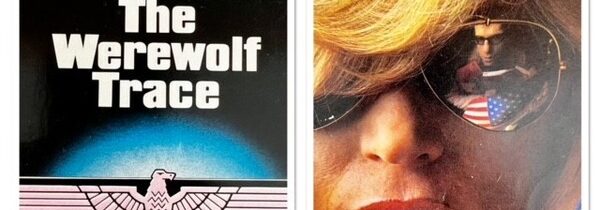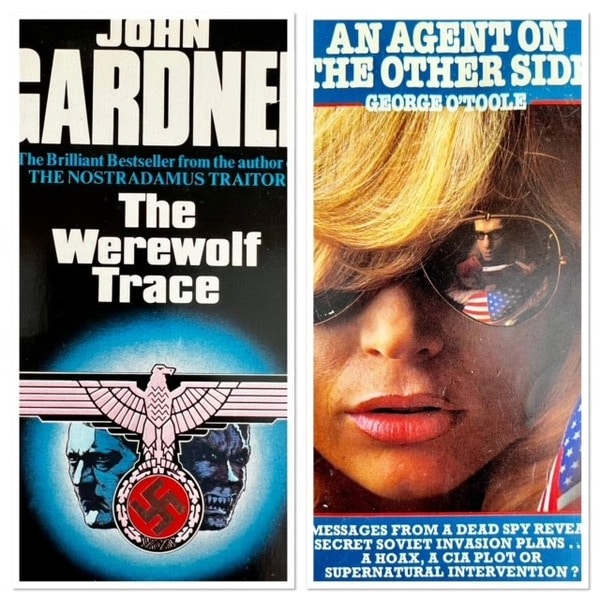SPOOKS AND SPOOKS: FORGOTTEN THRILLERS – SUPERNATURAL SPY NOVELS BY GEORGE O’TOOLE AND JOHN GARDNER
Spies and ghosts are not an usual combination. There are exceptions, such as Raymond Hawkey’s compelling It, but in general serious spy novels and the supernatural do not usually mix well together. However, in reading back through my collection recently I rediscovered two quite good spy novels from the 1970s where the supernatural plays a part.
George O’Toole was a former CIA agent and writer on espionage and history. An Agent On The Other Side (1973) would seem to have been his only novel, and is an interesting mix of spies and the
other-worldly.
The central premise is that on the eve of the Soviet invasion of Czechoslovakia in 1968, a young woman with psychic powers approaches the CIA and claims to be in touch with the spirit of the dead Russian spy Oleg Penkovsky. Whilst in a trance she provides information that only Penkovsky would know and reveals details of the upcoming invasion. The CIA are wary, but when another medium in Prague offers almost identical information for sale, they dispatch a small time film producer with links to the medium, John Sorel, to test the veracity of the supernatural connection.
After a slow start, the book picks up speed once Sorel reaches Prague. There are some good moments as he tries to track down the medium, including a darkly amusing séance in a spooky country home, and the usual swag of betrayals and behind-the-scenes manoeuvrings that you would expect from a 1970s spy novel. The tension builds over the final third of the book before culminating in a grim and exciting ending, that neatly wraps up what has gone before.
There is probably not enough supernatural elements to classify it as a real horror novel, but there are some interesting reflections on parapsychological research projects undertaken by the CIA in the late 1960s and a couple of good séances. The spy elements, presumably informed by O’Toole’s time in the CIA, are actually well done with good tradecraft and credible office politics. There is also an interesting end note by O’Toole in which he briefly discusses the background to the story, including the real Oleg Penkovsky.
It was a bit slow in parts, and quite dated now, but overall I enjoyed An Agent On The Other Side, especially its ending. Well worth a read!
John Gardner is probably best remembered now for his James Bond continuation novels, his Boysie Oakes and Herbie Kruger series, and his three continuation novels containing Sir Arthur Conan Doyle’s fictional villain, Professor Moriarty. But he also wrote some very good, and slightly offbeat, stand alone thrillers in the 1970s, such as The Dancing Dodo, which are the equal of his various ongoing series.
The Werewolf Trace (1977) was one of his stand alone books, and is a curious spy novel about a British operation to thwart a possible Nazi revival sparked by a possible heir to Hitler’s legacy. The operation leads back to the closing hours of the Third Reich, and a story about Adolf Hitler emerging from his bunker and singling out for special decoration one of the uniformed boys who were the last defenders of Berlin. The boy was then supposedly spirited out of Berlin and sent to live in South America. In 1977 the boy is now a well respected British businessman with possible links to Nazi elements and unclear parentage. British Intelligence mount an intensive operation to spy on the businessman and his family in their country residence in Surrey, to see whether he is a threat, or not.
The man, Joseph Gotterson, is oblivious to the listening devices and the attention of British Intelligence, but is haunted by his childhood memories and by a sinister presence in the farmhouse.
This is a slow-burn of a spy story. Gardner takes his time in setting up the book’s central conceit and in fleshing out the backgrounds of Gotterson and his wife. There is plenty of interesting detail about Hitler’s last days, as well as the historical background to the farmhouse. The British agents are also well sketched, especially the increasing jaded evaluator Vincent Cooling. Enhancing it are some amusing tongue in cheek references to spy fiction, especially when Cooling is greeted after his return from Berlin:
“‘You’re a registered package,’ grinned Greg. ‘Very valuable. I expect that they’re got a luxury penthouse for you’
‘James Bond rules. Okay?’ chuckled Bud.
It takes some time for the suspense to mount, but the ending is sharp and brutal, and I don’t think that many publishers would agree to it today.
The supernatural elements are muted, but there, and the two forms of haunting experienced by Gotterson and his family are neatly juxtaposed.
In end, The Werewolf Trace, is interesting rather than exciting. The details of the British operation are well described and convincing, but the logic behind the operation never really makes sense. It also unfolds very slowly.
It is a short book and quite a quick read, but is not as engaging as Gardner’s other spy novels.
In all, neither of the books have enough supernatural elements to satisfy horror fans, but they do cast an interesting light on the breadth of spy fiction in the 1970s. And they both feature a brevity of telling that is very rare these days.




